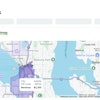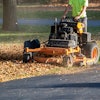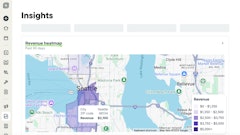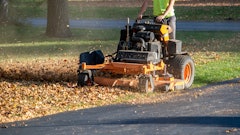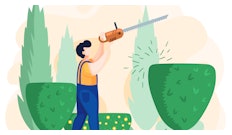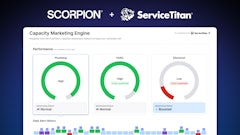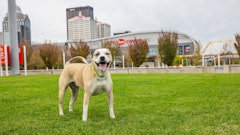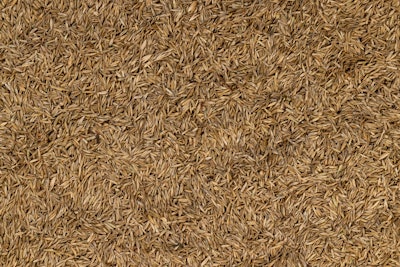
Professional contractors have to work hard to stay competitive. Not only do they need to produce high-quality results, but they also need to find repeatable jobs that reliably produce revenue. Aerating and overseeding are both repeating jobs that help contractors provide value to customers.
The efficiency of modern, ride-on aerators and overseeders help green industry professionals to expand their services, smooth over seasonal revenue gaps, and build a base of recurring customers. And even though ride-on aerators and overseeders are an investment, the numbers show they pay for themselves quickly and can help contractors perform one of the most profitable turf care services available.
Aeration and overseeding almost sell themselves when presented to homeowners in simple terms. Turf inevitably becomes compacted over time from foot traffic, equipment use, kids playing in the yard, and even heavy rainfall. Compacted soil squeezes out air and prevents roots from accessing the oxygen, water, and nutrients they need. Aeration reverses that process, pulling cores from the lawn to open up the soil.
Overseeding complements the work by introducing new growth that enhances density, color, and disease resistance. Together, the services help create a healthier, thicker lawn without relying on expensive chemical inputs. Customers often respond well to the promise of visible results and environmentally friendly solutions that make their yard the envy of the neighborhood.
Shoulder Season Revenue
For contractors, aeration and overseeding provide a variety of advantages that go well beyond customer satisfaction. They add much-needed revenue during shoulder seasons in the spring and fall, when mowing slows down but work crews still need to stay busy. The services lend themselves to repeat business, since most customers are eager to repeat the treatment annually or at least every other year. They also create opportunities to cross-sell other services such as fertilization, weed control, and topdressing. A contractor who presents aeration and overseeding as part of a long-term turf health program can sometimes win additional services and establish more loyal, recurring customers.
Pricing for aeration and overseeding is straightforward but needs to be calculated carefully. Most contractors charge based on square footage, with residential lawns typically falling in the range of $75 to $250 per aeration service, depending on lot size, location, turf type, and whether overseeding is included. On a per-thousand-square-foot basis, aeration alone often runs between $8 and $15, while combining aeration with overseeding will raise those rates.
The biggest variable input is seed. High-quality turf-type tall fescue or bluegrass blends often cost $2 to $3 per pound, and application rates typically run from four to around six pounds per thousand square feet. That means a ten-thousand-square-foot lawn might cost a contractor around a hundred dollars in seed. However, when priced correctly, this cost is easily absorbed in the job fee, leaving a strong margin. Because a skilled operator with efficient equipment can finish an average residential lawn in under an hour, labor costs remain low as well.
Efficiency is where equipment choice makes all the difference. Walk-behind aerators and broadcast seeders are serviceable, but they can slow crews down and create operator fatigue. Ride-on aerators and overseeders transform the economics of the service. They cover more ground in less time, reduce physical strain, and allow both aeration and seeding to be completed in a single pass. They also present a more professional image to customers. While the upfront investment is significant, often $10,000 to $22,000 per unit, the payoff is rapid once the machine is put to work.
More about profits on GreenIndustryPros.comTop Five Ways to Improve Lawncare Business Profits - There’s always room to increase profits by simply selling more to your repeat customers. How Starting With Soil Samples Can Increase Lawn Care Profits - Soil testing can take the guesswork out of achieving the desired lawn care results customers want. Revitalizing Turf ... and Profits - Landscape contractors find lawn renovation services to be a fast-track to growing business. |
Ride-On ROI Pays for Itself
The numbers tell the story.
Consider a contractor who estimates being able to service 250 lawns per year using a ride-on unit. If the average price for aeration and overseeding is $175 per lawn, the gross revenue for the season would be $43,750. Seed and fuel together might average $30 per job, creating variable costs of around $7,500 for the entire year. If one operator completes all the jobs and is paid $25 per hour, labor would total about $6,200. Subtracting those costs from revenue leaves roughly $30,000 in net return before equipment costs. With a $15,000 machine investment, the contractor pays off the unit comfortably within the first season. Calculated as ROI, that is 100 percent return in year one, with all subsequent years producing even stronger profits since the machine is already paid for.
| Labor Hours / Job | 1.0 Hour |
| Labor Cost / Job | $25 |
| Annual Jobs (estimate) | 250 |
| Annual Labor Cost | $6,200 |
| Revenue | $43,750 |
| Variable Costs | $13,700 |
| Net Before Equipment | $29,750 |
| Equipment Cost | $15,000 |
| Simple Payback (years) | 0.5 years (6 months) |
The long-term value of ride-on aerators and overseeders is even more compelling than the year-one payoff. Because the machines reduce fatigue and stress on crews, contractors experience lower turnover and improved morale. The units tend to require less frequent repair or replacement compared with overworked walk-behind models. They also create a more polished, professional appearance that helps sell jobs.
Most importantly, the service itself builds lasting customer relationships. Homeowners who invest in aeration and overseeding year after year are far more likely to sign up for fertilization packages, seasonal cleanups, or comprehensive turf management programs. What begins as a single service can become the foundation of a long-term customer account.
Best Practices
Profitability can be maximized through a few best practices. Contractors who present aeration and overseeding as a bundled “turf renovation package” often find that customers respond more positively than when the services are offered separately. Education is equally important. When homeowners understand the problems caused by compaction and the benefits of new seed varieties, they are far more willing to pay premium rates.
Marketing efforts should focus on spring and fall, when demand for turf improvement is highest. Contractors who schedule jobs by neighborhood or route reduce travel time and costs, which has a direct impact on profit. Even simple social media videos showing cores being pulled from the soil or fresh seed being applied can create powerful demand and reinforce the service’s value.
In the end, aeration and overseeding represent one of the most reliable, profitable, and customer-friendly services available to landscape contractors. They generate immediate results that customers can see, while at the same time producing recurring revenue opportunities that support long-term business growth. Ride-on aerators and overseeders may require an upfront investment, but their efficiency and speed allow contractors to scale quickly, cover more properties, and dramatically improve profit margins.
For any contractor looking to smooth cash flow, strengthen customer retention, and deliver high-quality results, the conclusion is clear: aeration and overseeding, supported by ride-on equipment, are among the smartest investments you can make.

